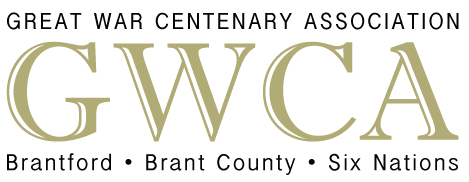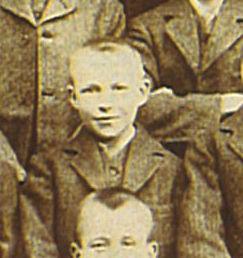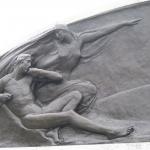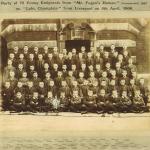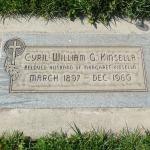Extract from: The Unveiling of the Bell Memorial at Brantford, Ontario, October 24th 1917
Sir Edmund Walker: (Great Applause).
Your Excellency, Your Honor, Mr. Mayor, Ladies and Gentlemen:
Nine years ago I was asked by the Committee of the Bell Memorial Association, because I happened to be Chairman of the Advisory Arts Committee of the Dominion Government, to help in drawing up the articles for competition for this memorial. I had a horror in my mind lest the people of Brantford might want a realistic memorial – a statue of Dr. Bell talking to an “Hello” girl, and it was tremendous relief to find that the Brantford Committee were quite clear in their minds that they wanted an ideal representation of the telephone, -- and I should not have been very much interested if they had not.
When the models came for examination, I was honored by being chosen one of a committee of three judges. There were nine models tendered which I believe may be seen at the Bell Homestead. I am glad that they are here because while personally I had no doubt whatever as to which was the finest of the nine models, (indeed I did not think there was any room for comparison between the model selected and any others) there was a great difference of opinion regarding that by many people of Brantford.
One of the vague rumours that comes to us from Germany is that they are very short of bronze, and they have destroyed hundreds of statues throughout that country during this war. If that be true, that is one of the minor blessings of the war for which we shall always have occasion to be thankful. A public status that will remain as long as bronze will endure is a tremendous responsibility, and the world is full of statues which should be melted up for better purposes.
This statue differs from almost any others which have been erected recently in the world’s history, and therefore it is quite natural when people look at it and find it is quite different from other statutes, that it should challenge their criticism. If they are not deeply interested in such things they are not pleased with it.
We have in the statue an attempt in a veiled and greatly dignified way to commemorate what the telephone subjectively means. There is a figure of humanity – a man’s figure – in the great relief. Here, let me tell you what I learned from Mr. Allward this morning. That figure is modeled from a man named Cyril Kinsella who cultivated the ground around Brantford, who went to the war, was wounded and sent home. He sat as a model for Mr. Allward, he got work as a fire-ranger but could not stand it, and he has gone back to the war again. (Applause). It is a delightful fact that the man who stands for humanity should be such a man as Cyril Kinsella.
Into his ear, what is intended to be a disembodied spirit, an angel or genius of the universe, is whispering that a power exists of which he has not yet been cognizant, and it tells him it is to transmit through the air the intelligence of joy, sorrow and knowledge that comes to man. I do not think a child with any powers of thinking about things subjectively could doubt what that wonderful relief means.
The other figures – they are draped in female form, and perhaps the reason is that women use the telephone more than men – (Laughter) – represent the idea of transmitting and receiving messages through the air.
Whatever people may think of this now, as time goes on I am quite sure that they will come to the conclusion that this is one of the greatest, if not the greatest, monuments on the North American Continent. (Applause).
Again as it has been erected at a time when the world is at war, it is a happy thing that it has been conceived by a man of very grave imagination, who thinks more of beauty and dignity than ornamentation. It has about it that kind of sobriety which is an attribute of things ideal. Even if erected while the world is engaged in the greatest war the world has known, it does not detract from the seriousness of this greatest moment in which we live.
The competition was open to the United States and Canada. When I discovered that some people in Brantford were unhappy in the selection that we made. I was greatly relieved by being told that the sculptor of the last model sent up, (a man from New York, who had heard me say that I liked his model best after Mr. Allward’s), has said to the others, “We none of us have any chance whatever alongside of that” – pointing to Mr. Allward’s model – “because he could not make it for twice the money”. In a word, you are to be congratulated on having something which I am perfectly sure, as the years roll by, will bring to Brantford countless people who will come for no other purpose than to see this remarkable memorial, commemorating the greatest invention in the history of the world.
At each end of the central relief are two disks, and these disks have Latin phrases inscribed in them, which are not very apparent for the moment. Mr. Allward is indebted to Professor Maurice Hutton for the beauty of the Latin phrases. They are intended to have two ideas: first, that the world has been re-created by the invention of the telephone, and second, that this monument is dedicated to the memory of the inventor of the telephone.
I have not attempted to speak in the voice of Mr. Allward. I am speaking as one of the committee who is in some sense responsible for the selection. Mr. Allward I was going to say is a Canadian, but he happens to be born in Newfoundland. However, he is a Canadian for all practical purposes. His art has been acquired entirely on this continent; he is a genius in his chosen work, and is recognized as such by the great sculptors of North America. We do not have to make the excuse, as we often do, that it is pretty good for a Canadian; it is, as a matter of fact, very good indeed for any sculptor no matter where he could have come from in the world. (Great applause).
BX May 4, 1946
War Veteran Sees For First Time The Bell Memorial Figure He Had Posed For
Cyril William Kinsella, veteran of the “Mad 4th” Battalion, is shown gazing for the first time, at the reclining figure of the figure of the man on the plaque of the Bell Memorial (commemorating the invention of the telephone here by Alexander Graham Bell in 1874) that he posed for.
Back in 1916, while convalescing in the hospital at Toronto from wounds he received at the second battle of Ypres (First Great War), Mr. Kinsella posed for the figure. Friday while the sun shone brightly on it, he stood gazing at it for the first time.
Coming from Tulare, California, where he owns and operates an 800 acre ranch, Mr. Kinsella told the Expositor the story of being chosen for the heroic size figure, over whom hovers another figure – Inspiration – with gracefully uplifted arm, pointing to three shadowy figures outlined at the far end of the panel as speeding through the air – the messengers of Knowledge, Joy and Sorrow.
“While I was convalescing in Toronto in 1916,” he said, “Walter S. Allward, designer and sculptor of the Memorial, chose me to pose for that figure,” he said pointing to it. “The posing was exacting and took about two months.”
Cyril William Kinsella enlisted in the 4th Battalion August 8, 1914. He was wounded at the second battle of Ypres and was invalided back to Canada. After his recovery – and posing for the figure on the Memorial – he went overseas again with the 124th Battalion and was transferred to his old love, the 4th Battalion.
“I just had to come back to see some of my old comrades of the 4th Battalion,” he said, referring to his coming from California for the reunion of the Battalion at Hamilton today and tomorrow which, incidentally, is being attended by many war veterans from Brantford and district.
“While in Hamilton,” he continued, “the urge to see myself in bronze on the monument that commemorates one of the greatest invention of man, became irresistible.”
Mr. Kinsella, who is the picture of health, came here with his wife and Leslie M. Glazier, President of the Hamilton Branch of the 4th Battalion Association and Mrs. Glazier.
San Luis Obispo, Telegram Tribune, December 27, 1960
William Kinsella Dies
GROVER CITY – Cyril William G. Kinsella, 62, a resident of Grover City for 23 years, died this morning in a San Luis Obispo hospital.
Mr. Kinsella was a native of London, England. He was a retired rancher, coming to this area from Tipton. He was a Canadian army veteran of World War 1.
He is survived by his widow, Mrs. Margaret Kinsella, Grover City; a stepson, Robert Cox, Los Angeles; a sister, Mrs. Mabel Lyon, England.
Funeral services will be Friday at 2 p.m. in the Wood funeral chapel, Arroyo Grande. Elder Lester Ortner of the Seventh-day Adventist church will officiate. Burial will be in the Arroyo Grande district cemetery.
